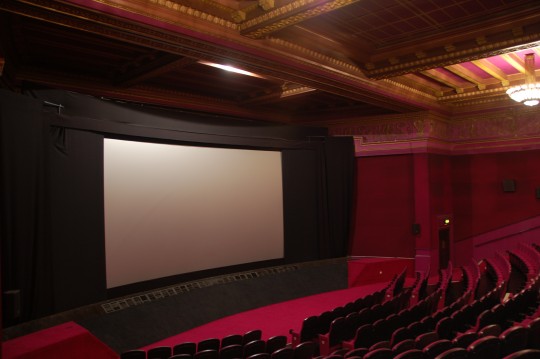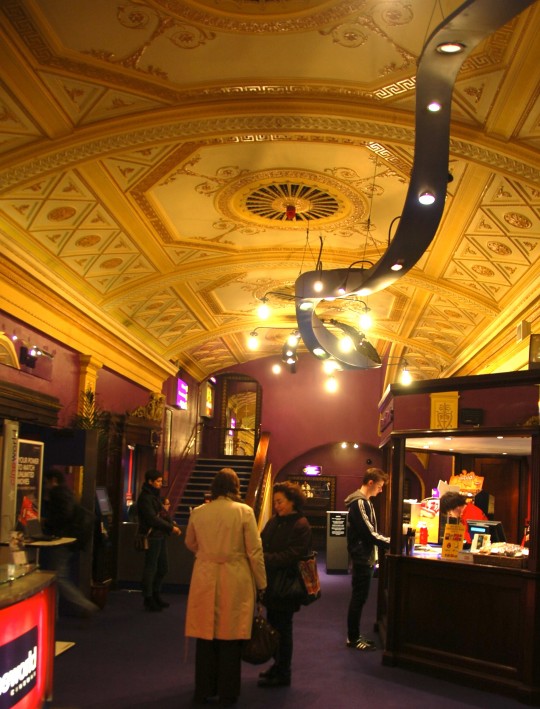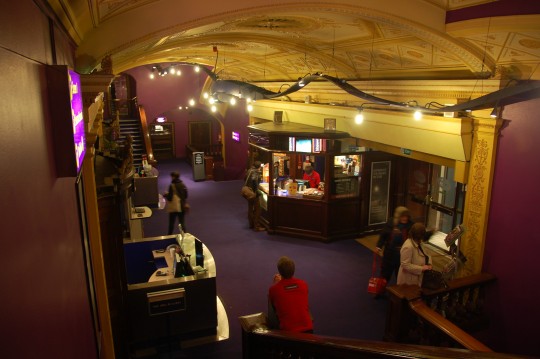Welcome to our new regular feature on the Cinema Experience. Being huge fans of Film, in addition to reviewing some of the latest movies (as well as a few classics) we’ll be writing about an overlooked side of going to the cinema – the venue itself. We want to showcase the kind of places that get everything just right to make you actually want to come back rather than just cramming people into a featureless multiplex.
It’s not often you have a surprisingly great cinema experience. Regardless of the film’s quality, the vast majority of our cinemas are charmless, boxy rooms that just happen to have a (sometimes) very large screen at one end. Add the fact that Britain, particularly London, has neglected or rejected it’s cinema heritage and it’s no wonder most people probably think it has always been like this.
London used to be crammed with ‘Picture Palaces’ when up until the 1980s there was a purpose built cinema or two on every high street, beautifully designed to conjure romantic images of exotic locations, or the grandeur of an epic event all before you’d even bought your ticket. How often have you walked past an Egyptian style Bingo Hall or the Art-Deco Palace of a Mega Church without realising they were originally built to pack in up to 2000 people a night for the Blockbuster of the day?
The decline in that cinema culture had debatable causes – competition from TV and home video are frequently quoted, but the fact is cinemagoing has been rapidly rising for a long time now – approaching the heyday of the 40s – and all while Home Cinema technology can seriously rival that of your average multiplex.. Could it be that people are still in love with the shared experience, transported to another time or place in a room full of complete strangers? If so, that experience is dramatically improved if you can approach cinema more like an event similar to seeing a West End show or your favourite band..
Leicester Square is a bit of a lucky dip for screens besides being the London home of Film Premieres. You’d expect the absolute best quality along with the corresponding ticket price. Sadly all cinemas on the square charge high prices regardless of screen size, and some are so small – less than 30 seats – vary wildly in quality, so unless you do some research you’re going to get ripped off.. Obviously there’s the Odeon’s 2000 seat auditorium but the screen itself seems too small for the space, and only the £22 per seat royal circle has a decent view! Far better can be found across the square in the Empire’s Screen 1, huge in every way (they just installed the new Dolby Atmos 64 channel sound) and 30% cheaper. It’s a shame they don’t make better use of the entrance and balcony, shared with the Empire Casino, as this should be the 1st choice for Premieres on the square.
However, the West End has overlooked gems deserving a lot more attention. It was a huge surprise entering a cinema I’ve walked past dozens of times, assuming it was a lifeless appendage to the Cineworld chain, and finding a charmingly theatrical entrance to what was originally a theatre turned cinema – converted to 3 screens. The Cineworld Haymarket has a slightly faded grandeur as you walk up to the main screen, hints of a rich history untouched by unnecessary renovation. This atmosphere continues into screen 1 – a medium/large cinema – lit only by the chandeliers above. Like many West End Theatres, the steep seating give great views wherever you’re sitting, the deep purple and gold wood panelling sets a luxurious mood framing the stage. The screen itself fills the stage perfectly and is set at just the right angle for the space – only the very ends of each row and the first few rows being a less than ideal view. Even the ads were mercifully short with just a 10 second anti-piracy ‘warning’.
“To the Wonder” is beautifully filmed in 35mm by cinematographer Emmanuel Lubezki
but unfortunately the cinema wasn’t sent a film print which would have made the experience perfect – so had to settle for video projection. The good news is, in addition to Film they have one of the best digital cinema installations we’ve seen. In technical terms NEC’s 4k DLP projector’s are much closer to rivalling Film quality than most of the competition. Each of the 3 DLP chips are 35mm in size throwing a much brighter image on screen with minimal digital imperfections. Colours & contrast are natural and vibrant with none of the dull murkiness you tend to get with digital. Crucially, being 3D capable – this doesn’t affect 2D performance as we’ve seen in some cinemas with skewed colours and a darker picture due to 3D polarisation. This may all sound very obscure but you really don’t want inferior digital equipment failing to reproduce director Terrence Malick’s sumptuous visuals..
This is a film that shouldn’t be approached as you would a traditional movie but rather as a visual poem, as pure cinema. It begins much like a symphony, both musically and visually, an almost abstract montage of emotion into which you bring your own baggage – out of which you take your own meaning. The script is virtually non-existent with the slenderest of plots broadly sweeping through the Paris romance of Ben Affleck and Olga Kurylenko who, along with her young daughter, are transplanted to suburban Oklahoma – taking in Mont Saint Michel on the way. Immediately the couple and child start to feel disillusioned with the remoteness of their new life and each other. They both have affairs and Olga takes her child back to France to live with her father and eventually returns to the US on her own. Javier Bardem plays a brief but significant role as her priest Father Quintana – another lost soul adrift in a foreign land.
The film is told via snatches of half heard dialogue, focusing on the moments immediately before or after a conversation – as if seen from a child’s perspective – unable to fully grasp the meaning of what was just said – sensitive to the raw feelings of elation or anger in adult relationships, the emotional cloud over rationality. To this effect every actor melts completely into the landscape, but Olga Kurylenko has a mesmeric quality, giving the only performance with which to anchor your allegiance. It’s difficult to care what happens to anyone else although saying this is no criticism of a film which isn’t trying to entertain an audience with a story but is the product of a director with a background of Philosophy at Harvard, Oxford and MIT, whose films are increasingly transcendent musings on life, love, and religion.
And this is where the film fails. Whereas in his 1998 return to cinema, The Thin Red Line, Malick suspends narrative time in the middle of a brutal battle, momentarily taking you outside the extreme or grim present to appreciate our relationship to life, environment and our capacity for destruction, here Terrence Malick directs the whole film in detached introspection, slowly revealing a rather cynical view of the emptiness of Life and the ultimate futility of Love in a godless world. The priest having a crisis of faith, feeling loneliness and despair at the thought of such a life seems to deny the possibility of a meaningful existence grounded in the world, with faith in humanity and love itself the driving factor – whether brief or long lived.
Malick may have inadvertently made a 100 minute metaphor of religion. A vague, detached and contradictory view of reality. Judgemental of human relationships and those who live happily without god. At a glance, it’s a frequently beautiful poetic experience. Sit through the whole thing and scratch beneath the surface – you’ll find a repetitive, evasive philosophical ramble, the ultimate goal of which is not to answer or even pose great questions about the nature of humanity, but to assert without evidence the views of a particular religious mindset.
Deeply flawed though it is, viewing this film on the big screen is an experience you’re unlikely to find at the cinema for a long time. With nearly every top cinematographer now shooting on video it’ll be many years before digital technology catches up with the inherent beauty of Film – if ever…
Whatever the format though – Cineworld Haymarket is one of the best places to watch movies in the West End. The management and staff seem to genuinely care about running a unique cinema experience which should be near the top of everyone’s list to watch Film in London.
Words by Jon Neal
Photos by Ben Neal



